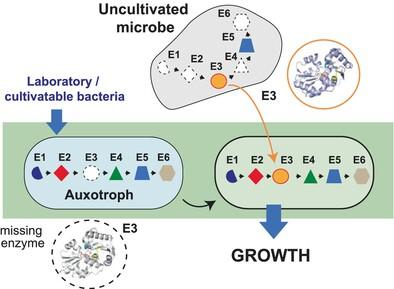当前位置:
X-MOL 学术
›
Environ. Microbiol.
›
论文详情
Our official English website, www.x-mol.net, welcomes your feedback! (Note: you will need to create a separate account there.)
Experimental evidence of d‐glutamate racemase activity in the uncultivated bacterium Candidatus Saccharimonas aalborgensis
Environmental Microbiology ( IF 5.1 ) Pub Date : 2024-04-01 , DOI: 10.1111/1462-2920.16621 Marcos Peñalver 1, 2, 3 , Alberto Paradela 4 , César Palacios‐Cuéllar 1 , M. Graciela Pucciarelli 1, 2, 3 , Francisco García‐del Portillo 1
Environmental Microbiology ( IF 5.1 ) Pub Date : 2024-04-01 , DOI: 10.1111/1462-2920.16621 Marcos Peñalver 1, 2, 3 , Alberto Paradela 4 , César Palacios‐Cuéllar 1 , M. Graciela Pucciarelli 1, 2, 3 , Francisco García‐del Portillo 1
Affiliation

|
The Candidate Phyla Radiation (CPR) encompasses widespread uncultivated bacteria with reduced genomes and limited metabolic capacities. Most CPR bacteria lack the minimal set of enzymes required for peptidoglycan (PG) synthesis, leaving it unclear how these bacteria produce this essential envelope component. In this study, we analysed the distribution of d ‐amino acid racemases that produce the universal PG components d ‐glutamate (d ‐Glu) or d ‐alanine (d ‐Ala). We also examined moonlighting enzymes that synthesize d ‐Glu or d ‐Ala. Unlike other phyla in the domain Bacteria, CPR bacteria do not exhibit these moonlighting activities and have, at most, one gene encoding either a Glu or Ala racemase. One of these ‘orphan’ racemases is a predicted Glu racemase (MurICPR ) from the CPR bacterium Candidatus Saccharimonas aalborgenesis . The expression of MurICPR restores the growth of a Salmonella d ‐Glu auxotroph lacking its endogenous racemase and results in the substitution of l ‐Ala by serine as the first residue in a fraction of the PG stem peptides. In vitro, MurICPR exclusively racemizes Glu as a substrate. Therefore, Ca. Saccharimonas aalborgensis may couple Glu racemization to serine and d ‐Glu incorporation into the stem peptide. Our findings provide the first insights into the synthesis of PG by an uncultivated environmental bacterium and illustrate how to experimentally test enzymatic activities from CPR bacteria related to PG metabolism.
中文翻译:

未培养的细菌 Candidatus Saccharimonas aalborgensis 中 d-谷氨酸消旋酶活性的实验证据
候选门辐射(CPR)包括广泛存在的、基因组减少且代谢能力有限的未培养细菌。大多数 CPR 细菌缺乏肽聚糖 (PG) 合成所需的最小酶组,因此尚不清楚这些细菌如何产生这种必需的包膜成分。在本研究中,我们分析了d ‐产生通用PG成分的氨基酸消旋酶d ‐谷氨酸(d ‐谷氨酸)或d ‐丙氨酸(d -翼)。我们还检查了合成酶d ‐谷氨酸或d -翼。与细菌领域的其他门不同,CPR 细菌不表现出这些兼职活动,并且最多具有一个编码 Glu 或 Ala 消旋酶的基因。这些“孤儿”消旋酶之一是预测的 Glu 消旋酶(MurI心肺复苏 )来自 CPR 细菌糖单胞菌 。 MurI的表达心肺复苏 恢复生长沙门氏菌 d ‐Glu 营养缺陷型缺乏内源性消旋酶,导致取代我 ‐Ala 由丝氨酸作为 PG 干肽片段中的第一个残基。体外,MurI心肺复苏 专门外消旋 Glu 作为底物。所以,约。阿尔伯克糖单胞菌 可能将 Glu 外消旋化与丝氨酸偶联,d ‐Glu 掺入茎肽中。我们的研究结果首次深入了解了未培养的环境细菌合成 PG 的情况,并说明了如何通过实验测试 CPR 细菌与 PG 代谢相关的酶活性。
更新日期:2024-04-01
中文翻译:

未培养的细菌 Candidatus Saccharimonas aalborgensis 中 d-谷氨酸消旋酶活性的实验证据
候选门辐射(CPR)包括广泛存在的、基因组减少且代谢能力有限的未培养细菌。大多数 CPR 细菌缺乏肽聚糖 (PG) 合成所需的最小酶组,因此尚不清楚这些细菌如何产生这种必需的包膜成分。在本研究中,我们分析了



























 京公网安备 11010802027423号
京公网安备 11010802027423号